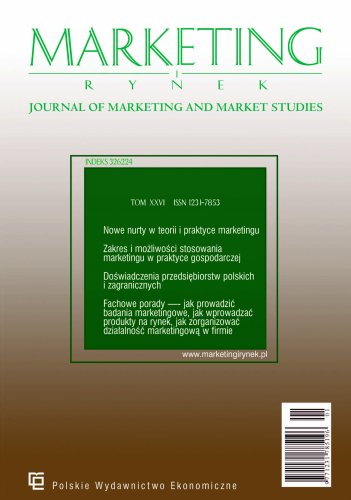The influence of online activity of social media users on the brand equity of famous people
Famous people more and more often realise that the greater their personal brand equity based on consumers (social media users), the easier it is for them to achieve their goals. This is proved by advertising contracts that are formed with people who have a large number of "followers" or "likes" on social media. In other words, a strong personal brand is the key capital of a famous person, and its shaping should be the subject of a carefully prepared image strategy. Social media users have a very important role to play in this strategy, which is highlighted in this article. The main purpose of this article is to determine the importance of social media in shaping personal brand. Based on 26 in-depth individual interviews that were conducted with people famous in Poland and surveys of a group of 324 social media users, it was shown, among others, that online activity of Internet users stimulates the brand equity of famous people. Statistically significant relationships were observed for such components of the personal brand as awareness/associations with the personal brand and for the relationship regarding the perception of the quality of activities carried out by a famous person.
References
Bibliografia/References
Aaker, D. A. (1991). Managing brand equity: Capitalizing on the value of a brand name. New York: The Free Press.
Aaker, D. A. (1996). Measuring brand equity across products and markets. California Management Review, 38(2), 102–120. https://doi.org/10.2307/41165845
Aaker, D. A. i Joachimsthaler, E. (2000). Brand leadership. Building assets in an information economy. New York: The Free Press.
Aczel, A. D. i Sounderpandian, J. (2017). Statystyka w zarządzaniu. Warszawa: Wydawnictwo PWN.
de Chernatony, L. (2003). Marka. Wizja i tworzenie marki. Gdańsk: Gdańskie Wydawnictwo Psychologiczne.
Grzegorczyk, A. (2018). Celebrities in the culture industry. Cultural Management: Science and Education, 2(1), 71–80. https://doi.org/10.30819/cmse.2-1.04
Grzesiak, M. (2018). Personal Brand Creation in the Digital Age. Theory, Research and Practice. Warsaw: Palgrave Pivot. https://doi.org/10.1007/978-3-319-69697-3
Hajduk, G. i Mróz-Gorgoń, B. (2017). Rola strategii w zarządzaniu rozwojem instytucji kultury. W: Ł. Wróblewski (red.), Marketingowe oraz społeczne aspekty zarządzania w kulturze. Toruń: Wydawnictwo Adam Marszałek.
Keller, K. L. (1993). Conceptualizing, measuring, and Managing Customer-Based Brand Equity. Journal of Marketing, 57, 1–22. https://doi.org/10.1177/002224299305700101
Konarski, R. (2015). Modele równań strukturalnych. Teoria i praktyka. Warszawa: Wydawnictwo PWN.
Malinowska-Parzydło, J. (2015). Jesteś marką. Jak odnieść sukces i pozostać sobą. Gliwice: Wydawnictwo Helion.
Muntinga, D. G., Moorman, M. i Smit, E. G. (2011). Introducing COBRAs: Exploring motivations for brand-related social media use. International Journal of Advertising, 30(1), 13–46. https://doi.org/10.2501/IJA-30-1-013-046
Mróz-Gorgoń, B. (2014). Marketingowe aspekty wykorzystania mediów społecznościowych przez marki modowe w Polsce. W: Marketing i Rynek, 8 [CD], I. Escher, J. Petrykowska i D. Szostek (red.), s. 577–582. Warszawa: Polskie Wydawnictwo Ekonomiczne.
Niczewski, R. i Potrzebowski, J. (2010). Celebryci w ataku. Celebrity effect jako skuteczne narzędzie komunikacji marketingowej. Warszawa: Agora.
Niedźwiedziński, M., Klepacz, H. i Szymańska, K. (2016). Budowanie marki osobistej w mediach społecznościowych. Marketing i Zarządzanie, 4(45), 39–349. https://doi.org/10.18276/miz.2016.45-30
Rozwadowska, B. (2002). Public relations — teoria, praktyka, perspektywy. Warszawa: Wydawnictwo Studio Emka.
Schivinski, B. i Brzozowska-Woś, M. (2015). Badanie aktywności online polskich konsumentów dotyczącej marek. e-mentor, 2(59), 77–85. https://doi.org/10.15219/em59.1174
Smith, P. R. i Zook, Z. (2011). Marketing Communications: Integrating Offline and Online with Social Media. London: Kogan Page Publishers. Social Media Audiences and the Museum. (2018). http://www.museumnext.org/2010/blog/ research-social-media-audiences-and-the-museum [odczyt: 19 grudnia 2018]. http://www.museumnext.org/2010/blog/
Timm, N. H. (2002). Applied Multivariate Analysis. Heidelberg, Germant: Springer.
Treadwell, D. F. i Harrison, T. M. (1994). Conceptualizing and Assessing Organizational Image Model Images, Commitment, and Communication. Communication Monographs, 61. https://doi.org/10.1080/03637759409376323
Tworzydło, D. (2008). Macierz celów wizerunkowych w procesie oceny efektów public relations. Rzeszów: Wydawnictwo WSIiZ.
Villarejo-Ramos, A. F. i Sánchez-Franco, M. J. (2005). The impact of marketing communication and price promotion on brand equity. Journal of Brand Management, 12(6), 431–445. https://doi.org/10.1057/palgrave.bm.2540238
Walczak-Skałecka, A. (2018). Granice pojęcia „marka osobista”. Annales Universitatis Mariae Curie-Sklodowska, 43(1), 269–286. https://doi.org/10.17951/i.2018.43.1.269-286
Walsh, G., Mitchell, V. W., Jackson, P. R. i Beatty S. E. (2009). Examining the antecedents and consequences of corporate reputation: A customer perspective. British Journal of Management, 20(2), 187–203. https://doi.org/10.1111/j.1467-8551.2007.00557.x
Wróblewski, Ł., Bilińska-Reformat, K. i Grzesiak, M. (2018). Sustainable Activity of Cultural Service Consumers of Social Media Users — Influence on the Brand Capital of Cultural Institutions. Sustainability, 10. https://doi.org/10.3390/su10113986
Wróblewski, Ł. i Grzesiak, M. (2020), The Impact of Social Media on the Brand Capital of Famous People. Sustainability, 12, 6414. https://doi.org/10.3390/su12166414
Yoo, B., Donthu, N. i Lee, S. (2000). An examination of selected marketing mix elements and brand equity. Journal of the Academy of Marketing Science, 28(2), 1–14. https://doi.org/10.1177/0092070300282002
Yoo, B. i Donthu, N. (2001). Developing and validating a multidimensional consumer-based brand equity scale. Journal of Business Research, 52(1), 1–14. https://doi.org/10.1016/S0148-2963(99)00098-3

